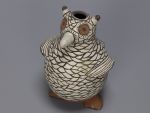Owl Figure
About this object
Narrative
Pottery owls became important tourist items when the railroad and then Route 66 allowed for large numbers of tourists to travel to the Southwest. This collection of 192 Zuni pottery owls includes examples from before 1900 through 2006. Zuni potters continue to make owls and family traditions in the medium continue. While many younger potters are innovating, the owls are distinctly Zuni.
Iconographic meaning
In traditional Zuni lore, the owl is considered a wise guardian and protector. An owl’s ability to see at night means that it sees what others cannot, giving it understanding of the spiritual and physical world.
Physical description
Fat, hand made, gourd-shaped clay owl has painted orange bottom and stands on large orange triangular feet with their base painted black. Large recessed eyes are also orange; all other details are hand painted in black over the creamy white background. Owl has a large round opening between the ears, a white finger-like beak, and long striped wings.
Date Made
C. 1960
Date Acquired
24 Feb 2009
How Acquired
Donated
Credit Line
The David Evans & Daniel Ma Southwest CollectionMore...
Measurements
Overall: 22 cm x 14 cm x 15.5 cm
Object Number
2731/96
